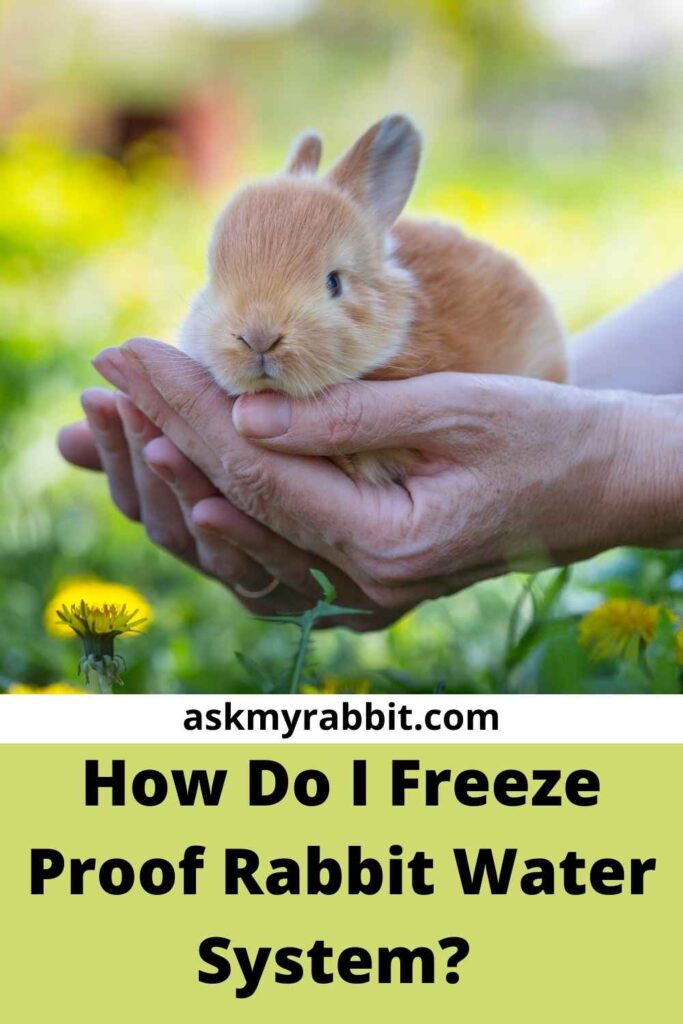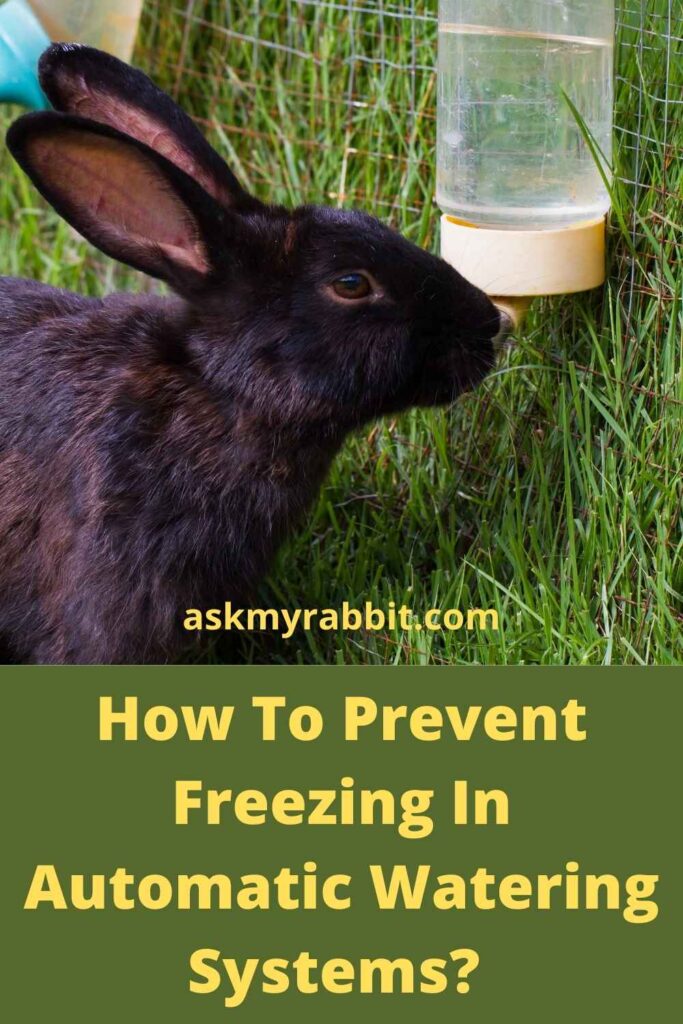Rabbits require water to survive. As a result, bunnies should always have access to a water bottle or other source of water.
However, during the winter, this might be difficult. If your rabbit’s water bottle freezes, he or she may become thirsty and have health issues as a result of dehydration.
So, you may be thinking, what do I do if my rabbit’s water bottle is freezing?
You have options for keeping your rabbit’s water bottle from freezing. The most fool proof method is to alternate frozen and thawed bottles stored inside.
You may also avoid freezing by getting a sippy spout. This will insulate the exterior of your rabbit’s bottle. Water can be treated with additives like glycerin to reduce the freezing time. Commercially available hot water bottles can also be used.
If you want to learn more about the ways you can keep your bunnies hydrated, keep reading!

How Do I Keep My Rabbit Water Bottle From Freezing?
You may follow these tips to keep your rabbit’s water bottle from freezing:
1. Bottle Spout
The style of water spout on your rabbit’s water bottle might make the difference between a healthy, hydrated pet and a thirsty one. A metal spout with a ball that dispenses water when the rabbit licks it is available. A sippy spout that does not leak is available too.
Water bottles with the metal spout may freeze in colder conditions. Bottles with sippy spouts are more expensive, but they last longer. Choose soft, opaque plastic that won’t shatter when it’s chilly outside when buying plastic bottles.
2. Insulator
You may construct a bottle insulator by putting bubble wrap over the bottle and placing a thermal sock over it. This will keep the water at a drinking temperature. Bottle insulators are also available commercially and fit snugly over the bottles. If you’re in a hurry, a warm glove will suffice.
3. Protection In Cage
Rabbit owners who are responsible ensure that their pets’ outside cages provide enough protection for their fluffy companions. Domestic rabbits should have proper winter shelter built so that they are protected from the north wind.
While proper ventilation is essential for rabbit health, securing a plastic sheet to the hutch can help insulate. It may keep bunnies healthy throughout the winter months. A well-insulated hutch is essential for keeping outside rabbits warm and avoiding their water bottles from freezing.
How Do You Water Rabbits In The Winter?
Although rabbits enjoy the cold, you need still keep them safe from damp and wind throughout the winter. In order to provide a supply of water in winter, keep an extra water bottle for your rabbit inside the house. You can replace it if one freezes.
During the chilly winter months, feed your rabbit celery and carrots. This will ensure that your rabbit is well hydrated and receiving sufficient water.
How Do I Freeze Proof Rabbit Water System?
You can follow these tips in order to freeze proof your bunny’s water system:

1. Bottles Should Be Rotated
Keeping thawed water bottles on hand is the most basic way. This may be accomplished by keeping a water bottle indoors at all times so that it remains unfrozen at normal temperature.
Simply switch an outside, frozen bottle for an interior, unfrozen one as the weather dips. Once that replacement has froze, replace it with a new one. Although you may simply bring the frozen bottle inside to defrost, rabbits should not be left without water for more than eight hours.
It’s best to warm up the new bottle somewhat before placing it outside while replacing the old one. This will prevent it from freezing right away. It may also make your rabbit feel more at ease during the colder months.
One of the most successful techniques is to rotate bottles. It’s a simple process if you don’t have a lot of bunnies or water bottles.
2. Choose Proper Spout
The nozzle on your rabbit’s water bottle can also help protect its water supply from freezing. When it comes to water bottles, there are two distinct spouts to select from.
A metal spout with a ball that travels up and down to release water is one example. A sippy spout is that bunnies can sip water from is another.
The metal-ball design might freeze in place during the colder months. As a result, there might still be unfrozen water within the bottle, but the rabbit won’t be able to get to it.
When compared to the sippy spout design, this is a much better option. In locations exposed to air, water will begin to freeze. This implies that in a sippy cup, it will likely freeze from the top alone, enabling the bottom to discharge water.
This will not keep the bottle from totally freezing over time, especially on cold nights. A sippy spout, on the other hand, can slow the process down so you don’t have to change the bottle as frequently. It may even persist during a cold period without your involvement.
3. Insulation
Insulation is an excellent method to protect your rabbit’s water bottle from becoming frozen. This protects the water from freezing by shielding it from cold air, similar to how your rabbit’s thick coat protects its body.
You may simply create your own insulator out of household materials. Collect some bubble wrap and a thermal sock to build a bottle insulation. Simply put bubble wrap around the water bottle and then wrap it in a sock to make it.
4. Glycerin
The time it takes for the water bottle to freeze is extended if the water is kept warm. To the water, add a few drops of glycerin.
Glycerin is a substance made from vegetable or animal fat. When combined with water, it might make it take longer for the water to freeze.
Glycerol has a pleasant flavor and is transparent and water soluble. The flavor of glycerin may be unpleasant to a rabbit’s delicate taste receptors.
5. Containers That Are Smaller
Use a smaller container instead of a big bottle to protect your rabbit’s water supply from freezing. A rabbit might drink the water before it freezes if the container is small enough.
You’ll need more water bottles, all of which will need to be filled on a regular basis. This is especially true if you have a large number of rabbits.
Finally, you’ll need to know how long your rabbit takes to finish a bottle. You risk depriving your rabbit of water if you do not do so.
6. Shelter From The Cold
Keeping your rabbit’s shelter warm can help keep his water supply from freezing. You may insulate your rabbit’s hutch in a variety of ways.
An insulator can be placed on top of the hutch. This may be made out of whatever insulating material you have on hand. A tarpaulin or thick bedding, for example, might be useful.
Aside from that, a straw can be placed inside the hutch. Straw is excellent at trapping and retaining heat, which helps to warm the hutch.
Rabbits may also burrow within it to keep their body heat and become more comfortable. Alternatively, a heating pad can be used.
7. Bowls Or Crocks That Have Been Preheated
You can use crocks or bowls instead of a water bottle entirely. They aren’t the best at keeping water clean when compared to water bottles. In a bowl, however, it is much easier to keep water from freezing.
Similarly, there are many different types of heated crocks on the market. You won’t be limited in your selections as you would with hot water bottles.
In addition, they are more dependable than hot water bottles. Because the heater and thermostat are on the exterior of the bowl, this is the case.
You can make your own heated crock if you don’t want to buy one. All you need is a heat pad below a metal crock. Unfortunately, because metal is a heat conductor, this will not work with other materials.
A crock may be easier to handle with if you merely want to alternate water sources. Ice can be readily removed from a crock, unlike water bottles. This allows you to switch your water sources without having to wait for thaw times.
Can I Use Heated Rabbit Water Bottle?
Yes, you can use a heated water bottle for your rabbit. These models include a built-in heater that can be powered by electricity. They also include a built-in thermostat to prevent ice from forming in the water.
Consider hot water bottles if you don’t mind the price. While this may be a smart idea for certain business owners, it is not as trustworthy as other solutions. Built-in features on water bottles are prone to breaking.
Furthermore, despite of anti-chew features, your rabbits may nibble any exposed wires. These water bottles are not cheap. This may not be the most financially smart option for people who possess a large number of rabbits.
Heated water bottles, on the other hand, may be used as regular water bottles. You can simply disconnect the gadget and use it like you would any other water bottle.
How To Unfreeze A Rabbit’s Water Bottle?

Unfreezing a rabbit’s water bottle may be accomplished in two ways. They are:
1. Warm Water
The simplest technique to unfreeze a frozen water bottle is to submerge it in warm water. Alternatively, you may defrost the bottle by pouring warm water over it. Both approaches, however, can be time-consuming.
Warm water, rather than hot water, should be used to defrost water bottles. No matter what material your bottle is constructed of, a rapid shift in temperature might cause it to crack.
Furthermore, anything involving hot water can be dangerous. However, this may cause the thawing process to take longer.
You may use a stove or gas to assist the water reach a comfortable temperature. This is a low-energy technique to defrost water bottles, especially in isolated locations.
Avoid inhaling hot vapour or touching the water with your bare hands when using hot water. Also, keep your rabbit away from any sources of hot water.
If you have a lot of rabbits and require a constant supply of thawed water, try to stick to a schedule. Place frozen water bottles in a tub of hot water to defrost.
These thawed water bottles can be used in place of frozen water bottles. After that, immerse the frozen bottles in hot water and repeat the process.
2. Clunking
Another technique is clunking. This entails breaking the ice inside the bottle with a hammer. This may be effective, but it may cause harm to the bottle. Plastic water bottles can make clunking simpler.
Even with this technique, the ice in the bottle will need to be thawed. The thawing time will be less if the pieces are smaller. Leaving ice in the bottle, on the other hand, restricts how much water your rabbit may drink.
How To Prevent Freezing In Automatic Watering Systems?

Aside from water bottles, automatic watering systems have significant problems in sub-zero temperatures. These automatic systems are, in fact, the most susceptible to freezing. This is due to the fact that the gadgets contain two flaws.
1. Tubes
Water is fed into them by tubes or pipelines. These tubes or pipes are then connected to rabbit hutch drinking faucets. If one point freezes along the route, it will be difficult to defrost it quickly.
2. Drink Point
When a rabbit bites the spout, an internal seal opens, allowing water to flow into the rabbit’s mouth. The seal returns to its original place once the rabbit has left. This leaves a moist spot exposed to the air, which freezes.
Rather than attempting to defrost the damage, the ideal method is to prevent freezing. You can prevent the freezing of automated water system in two ways:
1. Insulation
Insulate the water pipes that supply your rabbit’s fountain. The cost of insulated pipes and hoses varies based on the type of material utilised. Polyethylene, elastomeric foams, and mineral wool are examples of these materials.
2. Thermostat
Use a recirculation system in conjunction with a thermostat. A thermostat is used in this system to maintain hot water in a reservoir. A pump then circulates the water to keep it from freezing.
Water is necessary for a rabbit’s survival. Even in the cold, it might be difficult to guarantee that your pet gets enough water. Hopefully, one of these ways will aid in the safe and healthy care of your rabbits.
Frequently Asked Questions
Can I Give My Rabbit A Blanket?
Yes, you can give your rabbit a blanket. Blankets and towels are excellent additions to a rabbit’s living quarters. However, make sure your pet isn’t ingesting a lot of cloth.
Will My Rabbit Be Okay Outside In The Winter?
Yes, they are capable of staying outside in the winter. Outdoor rabbits, in fact, acquire a thicker coat in the winter and molt to thin it out in the summer.
Why Do Rabbits Pee On Blankets?
Bunnies, like other pets, seek to stake a claim to our living spaces. When it comes to battling for what they want, they are territorial. One way they accomplish this is by urinating on the covers and leaving their scent behind.
Final Words
Fresh water should always be available to pet rabbits. Rabbits drink between twenty five and seventy five millilitres of water per pound of body weight each day.
Rabbits will be okay in cold weather if their habitat has been adequately prepared and their water source has not frozen. If a rabbit goes without water for longer than twenty-four hours, serious health problems might develop.
We hope this article has been able to answer all your queries regarding the hydration of your bunnies during winter. If you have any more doubts or questions, drop them in the comment section below!







